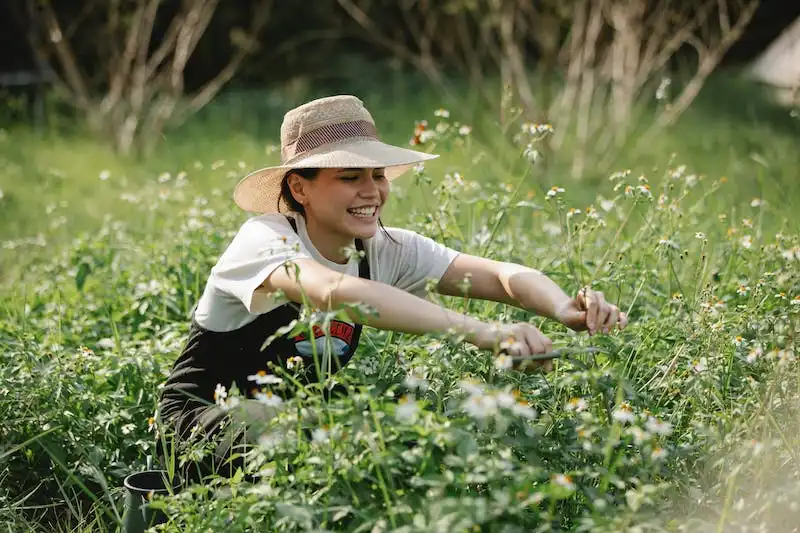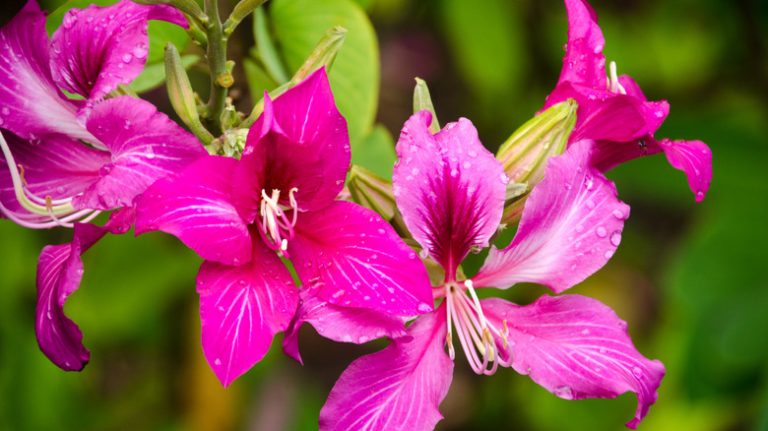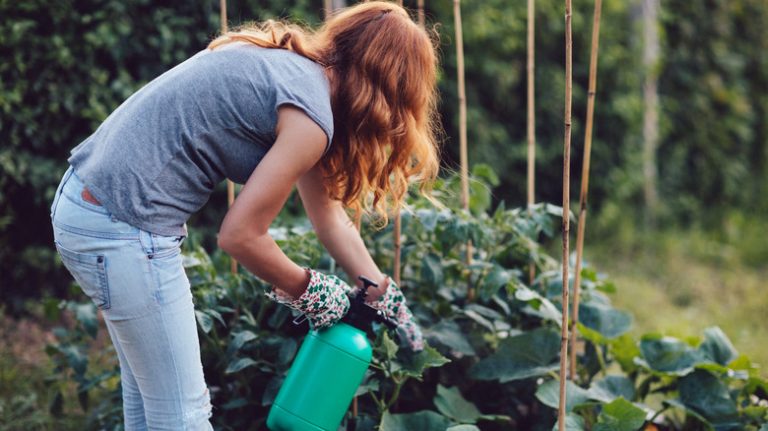When it comes to adding a pop of color to your garden, there’s nothing quite like nasturtiums. These beautiful and vibrant flowers not only attract beneficial insects and trapaeolum, but they can also be eaten! Nasturtiums are annual plants that are easy to grow, making them a great addition to any garden.
Nasturtium flowers come in a wide variety of colors, from pretty pinks and oranges to deep reds and yellows. Their leaves have a wonderful flavor that is similar to watercress, and their seedpods can also be used in cooking. In fact, nasturtiums are often recommended as a top edible flower for their superb taste.
To harvest nasturtiums, you simply need to pluck the flowers and leaves as needed. The flowers can be used as a garnish for salads or to add a pop of color to any dish. The leaves can be added to sauces or used as a wrap for summer rolls. You can even try your hand at making tempura-battered nasturtiums for a delicious treat.
In addition to their edible properties, nasturtiums are also great for the garden. They are known to attract beneficial insects and can be used as a natural trapaeolum to keep pests away from your other plants. Nasturtiums can also be used as a natural mulch to help retain moisture in the soil.
Whether you’re looking to add a touch of beauty to your garden or spice up your meals, nasturtiums are a wonderful addition. Learn how to harvest these edible flowers and enjoy their fantastic flavor in your cooking.
Nasturtiums
Nasturtiums (Tropaeolum majus) are annual flowering plants that are not only pretty to look at but also have edible flowers and leaves. They are easy to grow and are a great addition to any garden.
There are several varieties of nasturtiums available, including the Empress of India, which has deep green leaves and red flowers. The flowers of nasturtiums come in a range of colors, from vibrant yellows and oranges to softer pinks and reds. Their leaves can also vary in color, with some varieties having variegated or purple-tinged foliage.
One of the most common uses for nasturtiums is to harvest their edible flowers. The flowers have a mild, peppery flavor that can add a pop of color and taste to salads and other dishes. They can be eaten fresh or used as garnishes. Some people even enjoy deep-fried nasturtium flowers, which are often used as a topping for tempura-battered foods.
In addition to their flowers, the leaves of nasturtiums are also edible. They have a more intense peppery flavor than the flowers and can be used in salads or as a leafy green in cooked dishes. The seedpods of nasturtiums can also be eaten and have a similar flavor to capers.
When growing nasturtiums in your garden, they prefer full sun but can tolerate some shade. They are not fussy about soil conditions and will generally grow well in most garden soils. Nasturtiums can be started from seeds, which should be planted about one inch deep in the soil. They can also be grown from transplants, which are recommended if you want to get a jumpstart on the growing season.
To keep your nasturtiums growing well, be sure to water them regularly and provide a layer of mulch around the plants to help retain moisture. Nasturtiums are fairly low-maintenance and don’t require much fertilization. However, if your plants are not blooming as much as you would like, a light application of a balanced fertilizer can help stimulate more flower growth.
In addition to their beauty and edible qualities, nasturtiums can also be beneficial for your garden. They attract pollinators like bees and butterflies, and their strong scent can even help repel pests like aphids and whiteflies. Their sprawling growth habit can also help keep the soil cool and prevent weed growth.
So, if you’re looking for a wonderful addition to your edible garden, consider planting some nasturtiums. You’ll get to enjoy their pretty flowers and delicious flavor, and your garden will benefit from their growth and pest-repelling qualities.
About Nasturtiums
Nasturtiums (Tropaeolum majus) are annual plants that are native to South America, particularly Peru and Bolivia. They are known for their vibrant and beautiful flowers, which come in a wide range of colors such as yellow, orange, and red. Nasturtiums are not only admired for their ornamental value in gardens, but they are also valued for their edible flowers and leaves.
These edible flowers are often used as garnishes in salads, adding a pop of color and a peppery flavor. In fact, the name “nasturtium” comes from the Latin words “nasus tortus,” which means “twisted nose,” reflecting its pungent taste. The flavor of nasturtiums is often described as a combination of radish and watercress.
In Indian cuisine, nasturtiums are particularly popular and are used in various dishes, including salads, chutneys, and sauces. They are sometimes even stuffed or pickled. Nasturtium seedpods can also be harvested when they are still green and used as a substitute for capers.
Aside from their flavor and culinary uses, nasturtiums are also recommended for home gardens. They are easy to grow and are often used as companion plants to attract beneficial insects such as bees and butterflies. The leaves of nasturtium plants can act as a trap crop, luring pests away from other plants in the garden.
Nasturtiums can be grown from seeds and require little maintenance once established. They prefer well-drained soil and full sun to partial shade. The plants have a trailing growth habit, making them suitable for hanging baskets or for filling in empty spaces in the garden. With their pretty flowers and edible parts, nasturtiums are a wonderful addition to any garden and a great choice for those who enjoy growing their own food.
When it comes to picking nasturtiums to eat, it is best to harvest the flowers in the morning when they are at their freshest. The flowers can be used immediately or stored in a cool, dark place for later use. The leaves can also be harvested and used in salads or cooked as a green vegetable.
Overall, nasturtiums are a versatile and attractive plant that offers both ornamental and edible benefits. Whether they are used as a deep fried tempura-battered treat or simply as a pretty garnish for a summer salad, nasturtiums are a must-have in any garden.
Picking Nasturtiums To Eat – Learn How To Harvest Edible Nasturtiums
Edible nasturtiums (Tropaeolum majus) are not only beautiful flowers to add charm to your garden, but they also provide a tasty addition to your meals. Their vibrant colors and unique flavor make them a popular choice for garnishes and salads.
When it comes to picking nasturtiums to eat, it’s important to choose flowers that are at their peak. Look for fully bloomed flowers with petals that are still bright and vibrant. Avoid flowers that are starting to wilt or have brown spots.
The best time to harvest nasturtium flowers is in the morning when the dew has dried. Gently pick the flowers from the plant, making sure to leave some space for new growth. It’s recommended to cut the flowers with a pair of clean, sharp scissors rather than pulling them off, as this can damage the plant.
In addition to the flowers, nasturtium leaves are also edible and have a peppery flavor. You can harvest the leaves by simply plucking them from the stem. They can be added to salads or used to garnish dishes.
The seedpods of nasturtium can also be eaten. They have a milder flavor compared to the flowers and leaves. Harvest the seedpods when they are still green and firm. You can eat them raw or cook them in various dishes.
Once you have harvested your nasturtium flowers and leaves, it’s important to wash them thoroughly before consuming. Remove any dirt or bugs that may be clinging to them.
If you can’t eat your harvested nasturtiums right away, you can store them in the refrigerator. Place them in a container lined with damp paper towels and keep them in the crisper drawer. They should last for up to a week.
Nasturtiums are easy to grow and can be a wonderful addition to your garden. They are often used as trapaeolum plants in companion gardening, as they help to attract beneficial insects and deter pests. Their sprawling growth habit makes them ideal for filling in empty spaces in your garden.
There are many different varieties of nasturtiums to choose from, ranging in colors from vibrant oranges and yellows to deep reds and purples. Some popular varieties include ‘Empress of India’, ‘Alaska’, and ‘Climbing Mixed’.
In addition to their beauty and edible qualities, nasturtiums are also recommended for their medicinal properties. They are rich in vitamin C and have been used traditionally in India for their antibacterial and antifungal properties.
So next time you’re in your garden, consider picking some nasturtiums to eat. Their flowers, leaves, and seedpods can all be enjoyed and added to your favorite dishes. Whether you use them for pretty garnishes or as a unique ingredient, nasturtiums are a top choice for food lovers and gardeners alike.
Edible Nasturtium Flowers and Leaves
Nasturtiums are annual plants that are not only beautiful additions to your garden but also offer delicious and edible flowers and leaves. In fact, the entire plant is edible, from the vibrant flowers to the green leaves.
The flowers of nasturtiums have a wonderful flavour that is often described as peppery and slightly spicy. They can be eaten raw or used as a garnish to add a pop of color to salads, soups, and other dishes. The flowers can also be used to make sauces, vinegars, or even tempura-battered and fried.
The leaves of nasturtium plants are also edible and have a slightly milder flavor compared to the flowers. They can be used in salads or as a substitute for basil in pesto. Additionally, nasturtium leaves are a popular ingredient in Indian cuisine.
When harvesting nasturtium flowers and leaves for consumption, it’s recommended to pick them in the morning when their flavors are the strongest. Simply pinch off the flowers and leaves at the base of the plant, taking care not to damage the stems or other parts of the plant.
Once you’ve picked the edible nasturtiums, you can store them in the refrigerator for a few days. It’s best to place them in a container lined with damp paper towels to keep them fresh. Alternatively, you can store them in a sealed plastic bag, removing as much air as possible.
In addition to their culinary uses, nasturtiums also have other benefits in the garden. The bright flowers attract pollinators like bees and butterflies, helping to support a healthy ecosystem. Nasturtiums also act as a natural trap crop, attracting pest insects away from other plants in your garden.
When growing nasturtiums, keep in mind that they are annual plants and will only grow for one season. They are relatively easy to grow and can be started from seed. Nasturtiums prefer full sun but can tolerate partial shade. They also don’t require much water, though consistent moisture is needed for optimal growth.
In summary, nasturtiums are not only pretty flowers for your garden, but also offer edible flowers and leaves with a wonderful flavor. Whether you use them in salads, as garnishes, or in sauces, nasturtiums can add a delicious and unique touch to your culinary creations. So go ahead and start growing your own edible nasturtiums – you won’t be disappointed!
How to Harvest Edible Nasturtiums
Nasturtiums are not only beautiful flowers that attract bees and butterflies to your garden, but they are also edible and have a deep, peppery flavor. If you are growing nasturtiums in your garden, you can learn how to harvest these edible flowers, leaves, and seedpods to enjoy their wonderful flavor in your food.
When it comes to picking nasturtiums to eat, you can start by harvesting the flowers. The vibrant and colorful flowers can be used as garnishes for salads, sauces, and other dishes. Simply pick the flowers off the plant, making sure to remove the green base at the back of the flower, as this can be quite bitter. The flowers are also great for adding a pop of color to your summer gardens.
In addition to the flowers, the leaves of the nasturtium plants are also edible. The leaves have a peppery flavor that can add a little kick to your salads or be used as a topping for sandwiches. You can pick the leaves as needed, leaving enough on the plant to keep it growing.
If you are interested in trying something different, you can also harvest the seedpods of the nasturtiums. The seedpods can be eaten when they are still green and tender. They have a unique flavor and can be used in a variety of dishes, such as tempura-battered and fried. Just be sure to pick them when they are young, as older seedpods can become tough and woody.
One variety of nasturtiums that is worth mentioning is the Empress of India, which has deep red flowers and dark green leaves. The flowers of this heirloom variety are especially flavorful and the leaves are a vibrant addition to any garden. They can be used in the same way as other nasturtium varieties.
When harvesting nasturtiums, it’s important to keep in mind that these plants are annuals and have a sprawling growth habit. They can take up quite a bit of space in your garden, so make sure to give them the needed space to grow. To keep the plants healthy and productive, you can use mulch to keep the soil moist and prevent weeds from competing with them.
Now that you know how to harvest edible nasturtiums, you can enjoy their attractive flowers, deep flavors, and nutritious value in your meals. Whether you are using the flowers as garnishes or adding a little spice with the leaves, nasturtiums are a wonderful addition to any garden and your plate.




